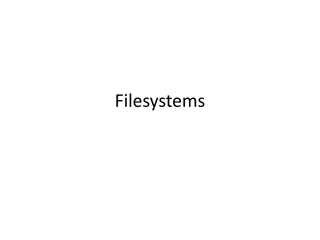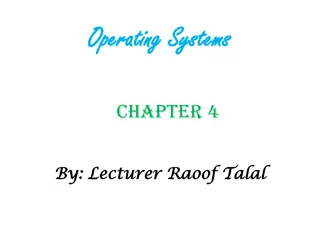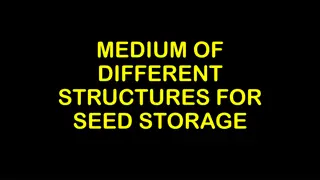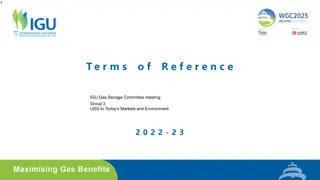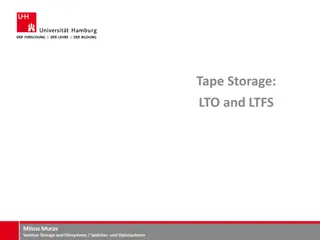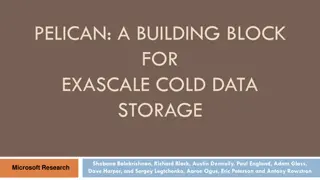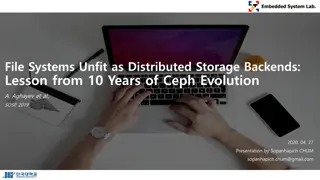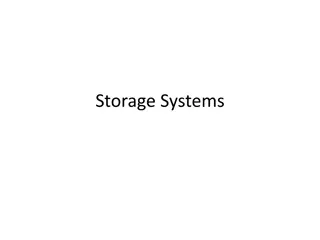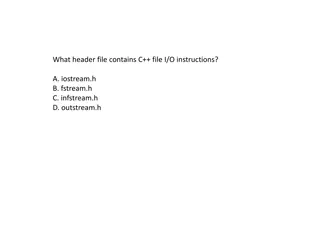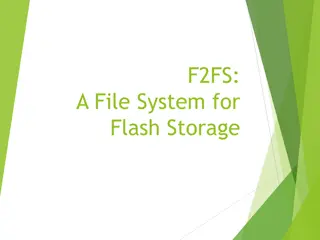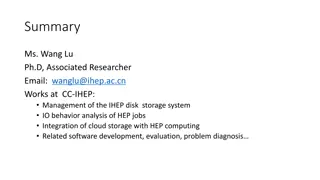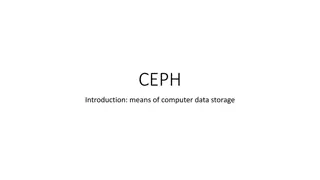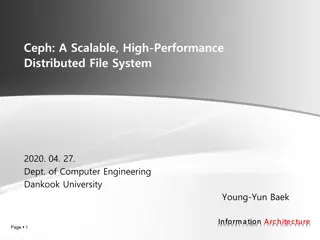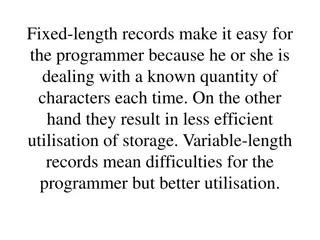Storage Systems: File Systems Overview
This content delves into the evolution and challenges of file systems, covering topics such as the design of log-structured file systems, historical context with UNIX file systems, and implementations like the Unix Berkeley Fast File System. It discusses issues with block sizes, inode placements, and disk layouts, offering insights into improving storage system performance. Various file representations, fragmentation issues, and key aspects of the FFS implementation are also explored.
Download Presentation

Please find below an Image/Link to download the presentation.
The content on the website is provided AS IS for your information and personal use only. It may not be sold, licensed, or shared on other websites without obtaining consent from the author.If you encounter any issues during the download, it is possible that the publisher has removed the file from their server.
You are allowed to download the files provided on this website for personal or commercial use, subject to the condition that they are used lawfully. All files are the property of their respective owners.
The content on the website is provided AS IS for your information and personal use only. It may not be sold, licensed, or shared on other websites without obtaining consent from the author.
E N D
Presentation Transcript
1 STORAGE SYSTEMS: FILE SYSTEMS Hakim Weatherspoon CS6410
Plan for today 2 Discuss Papers: The Design and Implementation of a Log-Structured File System (LFS), Mendel Rosenblum and Ousterhout. SOSP, 1991. Towards weakly consistent local storage systems (Yogurt), Ji-Yong Shin, Mahesh Balakrishnan, Tudor Marian, Jakub Szefer, Hakim Weatherspoon. SoCC 2016 Historical Context: UNIX File System (UFS) UNIX Berkeley Fast File System (FFS)
Background: Unix Fast File Sys Original UNIX File System (UFS) Simple, elegant, but slow 20 KB/sec/arm; ~2% of 1982 disk bandwidth Problems blocks too small consecutive blocks of files not close together (random placement for mature file system) i-nodes far from data (all i-nodes at the beginning of the disk, all data afterward) i-nodes of directory not close together no read-ahead 4
File system on disk freespace map inodes and blocks in use ... ... super block disk layout inodes inode size < block size data blocks 6
File representation file size link count access times ... data blocks data data data data data data data ... data data ... ... data data ... indirect block double indirect triple indirect ... data ... ... 7
The Unix Berkeley Fast File System Berkeley Unix (4.2BSD) 4kB and 8kB blocks (why not larger?) Large blocks and small fragments Reduces seek times by better placement of file blocks i-nodes correspond to files Disk divided into cylinders contains superblock, i-nodes, bitmap of free blocks, summary info Inodes and data blocks grouped together Fragmentation can still affect performance 8
FFS implementation Most operations do multiple disk writes File write: update block, inode modify time Create: write freespace map, write inode, write directory entry Write-back cache improves performance Benefits due to high write locality Disk writes must be a whole block Syncer process flushes writes every 30s 9
FFS Goals keep dir in cylinder group, spread out different dir s Allocate runs of blocks within a cylinder group, every once in a while switch to a new cylinder group (jump at 1MB). layout policy: global and local global policy allocates files & directories to cylinder groups. Picks optimal next block for block allocation. local allocation routines handle specific block requests. Select from a sequence of alternative if need to. 10
FFS locality don t let disk fill up in any one area paradox: for locality, spread unrelated things far apart note: FFS got 175KB/sec because free list contained sequential blocks (it did generate locality), but an old UFS had randomly ordered blocks and only got 30 KB/sec 11
FFS Results 20-40% of disk bandwidth for large reads/writes 10-20x original UNIX speeds Size: 3800 lines of code vs. 2700 in old system 10% of total disk space unusable 12
FFS Enhancements long file names (14 -> 255) advisory file locks (shared or exclusive) process id of holder stored with lock => can reclaim the lock if process is no longer around symbolic links (contrast to hard links) atomic rename capability (the only atomic read-modify-write operation, before this there was none) Disk Quotas Overallocation More likely to get sequential blocks; use later if not 13
FFS crash recovery Asynchronous writes are lost in a crash Fsync system call flushes dirty data Incomplete metadata operations can cause disk corruption (order is important) FFS metadata writes are synchronous Large potential decrease in performance Some OSes cut corners 14
After the crash Fsck file system consistency check Reconstructs freespace maps Checks inode link counts, file sizes Very time consuming Has to scan all directories and inodes 15
Perspective Features parameterize FS implementation for the HW in use measurement-driven design decisions locality wins Flaws measuremenets derived from a single installation. ignored technology trends Lessons Do not ignore underlying HW characteristics Contrasting research approach Improve status quo vs design something new 16
The Design and Impl of a Log-structured File System Mendel Rosenblum and John K. Ousterhout Mendel Rosenblum Designed LFS, PhD from Berkeley ACM Disseration Award Winner Professor at Stanford, designed SimOS Founder of VM Ware John Ousterhout Professor at Berkeley 1980-1994 Created Tcl scripting language and TK platform Research group designed Sprite OS and LFS Now professor at Stanford after 14 years in industry
The Log-Structured File System Technology Trends I/O becoming more and more of a bottleneck CPU speed increases faster than disk speed Big Memories: Caching improves read performance Most disk traffic are writes Little improvement in write performance Synchronous writes to metadata Metadata access dominates for small files e.g. Five seeks and I/Os to create a file file i-node (create), file data, directory entry, file i-node (finalize), directory i-node (modification time). 18
LFS in a nutshell Boost write throughput by writing all changes to disk contiguously Disk as an array of blocks, append at end Write data, indirect blocks, inodes together No need for a free block map Writes are written in segments ~1MB of continuous disk blocks Accumulated in cache and flushed at once Data layout on disk temporal locality (good for writing) rather than logical locality (good for reading). Why is this a better? Because caching helps reads but not writes! 19
Log operation Kernel buffer cache inode blocks data blocks active segment Disk log log head log tail 20
LFS design Increases write throughput from 5-10% of disk to 70% Removes synchronous writes Reduces long seeks Improves over FFS "Not more complicated" Outperforms FFS except for one case 21
LFS challenges Log retrieval on cache misses Locating inodes What happens when end of disk is reached? 22
Locating inodes Positions of data blocks and inodes change on each write Write out inode, indirect blocks too! Maintain an inode map Compact enough to fit in main memory Written to disk periodically at checkpoints Checkpoints (map of inode map) have special location on disk Used during crash recovery 23
Cleaning the log: Achilles Heel Log is infinite, but disk is finite Reuse the old parts of the log Clean old segments to recover space Writes to disk create holes Segments ranked by "liveness", age Segment cleaner "runs in background" Group slowly-changing blocks together Copy to new segment or "thread" into old 24
Cleaning policies Simulations to determine best policy Greedy: clean based on low utilization Cost-benefit: use age (time of last write) (free space generated)*(age of segment) cost benefit cost = Measure write cost Time disk is busy for each byte written Write cost 1.0 = no cleaning 25
Greedy versus Cost-benefit 26
LFS crash recovery Log and checkpointing Limited crash vulnerability At checkpoint flush active segment, inode map No fsck required 28
LFS performance Cleaning behaviour better than simulated predictions Performance compared to SunOS FFS Create-read-delete 10000 1k files Write 100-MB file sequentially, read back sequentially and randomly 29
Perspective Features CPU speed increasing faster than disk => I/O is bottleneck Write FS to log and treat log as truth; use cache for speed Problem Find/create long runs of (contiguous) disk space to write log Solution clean live data from segments, picking segments to clean based on a cost/benefit function Flaws Intra-file Fragmentation: LFS assumes entire files get written If small files get bigger , how would LFS compare to UNIX? Lesson Assumptions about primary and secondary in a design LFS made log the truth instead of just a recovery aid 32
Towards Weakly Consistent Local Storage Systems Ji Yong Shin, Mahesh Balakrishnan, Tudar Marian, Jakub Szefer, Hakim Weatherspoon Ji Yong Shin Student at Cornell, post-doc Yale Mahesh Balakrishnan Student at Cornell, Researcher at Microsoft Professor at Yale Tudor Marian Student at Cornell, Researcher at Google Jakub Szefer Professor at Yale Hakim Weatherspoon Student at Berkeley, Professor at Cornell
Motivation 34 Heterogeneity is storage is increasing Magnetic disks (hard disk drives), NAND-flash solid state drives (SSD), DRAM, NVRAM, hybrid drives, Intel 3DXpoint, Phase Change Memory (PCM) Exhibit different characteristics Number of storage devices is increasing And is log-structured / multi-versioned Local storage system starts to look like a distributed storage system
Research Question 35 Can we make local storage system weakly consistent like a distributed storage system? Weakly consistent means return stale (old versions) of data
StaleStores 36 Single-node storage system that maintains and servers multi-versions Allows application to make performance consistency tradeoff Higher performance and weak consistency for older version Vs low performance and high consistency for latest version
StaleStores 37 Requirements: Timestamped writes Snapshot reads Cost estimation Version exploration
StaleStores 38 Requirements: Timestamped writes Snapshot reads Cost estimation Version exploration API Put Get GetCost GetVersionedRange
Perspective Log-structured is a simple but power abstraction Performance is high since seeks are reduced However, performance suffers if disk nearly full Modern day resurrection of Log-Structrued SSD and heterogeneity of storage Future log-structured storage systems Trade-off consistency for performance 40
Next Time Read and write review: Survey paper due next Friday Check website for updated schedule
Next Time Read and write review: The Google file system, Sanjay Ghemawat, Howard Gobioff, Shun-Tak Leung. 19th ACM symposium on Operating systems principles (SOSP), October 2003, 29-- 43. Spanner: Google's Globally Distributed Database, James C. Corbett, Jeffrey Dean, Michael Epstein, Andrew Fikes, Christopher Frost, J. J. Furman, Sanjay Ghemawat, Andrey Gubarev, Christopher Heiser, Peter Hochschild, Wilson Hsieh, Sebastian Kanthak, Eugene Kogan, Hongyi Li, Alexander Lloyd, Sergey Melnik, David Mwaura, David Nagle, Sean Quinlan, Rajesh Rao, Lindsay Rolig, Yasushi Saito, Michal Szymaniak, Christopher Taylor, Ruth Wang, and Dale Woodford. In Proceedings of the 10th USENIX conference on Operating Systems Design and Implementation (OSDI'12), October 2012, 251--264.




